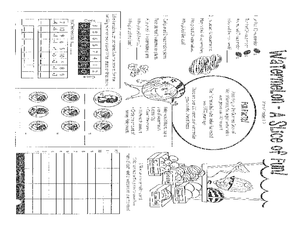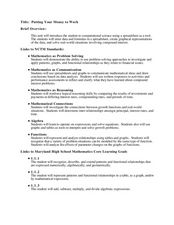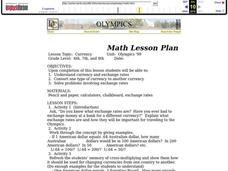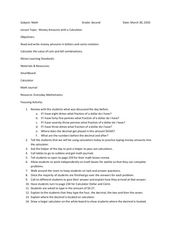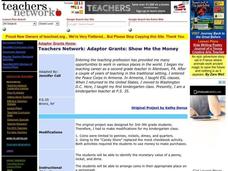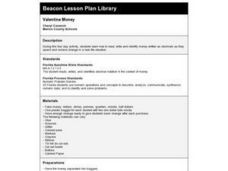Curated OER
Watermelon - A Slice of Fun
In this multiple math skills about watermelons worksheet, young scholars solve most and least word problems, subtract to solve a cod and find the answer to a question, count coins, and graph types of watermelons. Students solve 28...
Curated OER
Investing Money
Sixth graders participate in an simulated investment activity. They examine the purpose of different types of investments before they predict which will be the most successful. Finally, they simulate investing $1,000 in stocks, $1,000 in...
Curated OER
Putting Your Money to Work
Students create a collect data on expenses. In this algebra lesson plan, students create a spreadsheet to solve scientific equations. They incorporate math, science and technology in this lesson plan.
Workforce Solutions
Plan a Vacation
Challenge scholars to plan a vacation with a $5,000 budget. Learners review costs of transportation, meals, and entertainment while considering the number of people and destination. Worksheets provide information and well-organized...
Mathematics Assessment Project
Estimating Length Using Scientific Notation
Would you rather have a million dollars or 1 x 10^6 dollars? To find the answer to this question, class members first complete an assessment task converting numbers between decimal notation and scientific notation. They then take part in...
Henrico County Public Schools
Models for Teaching Addition and Subtraction of Integers
Positive and negative numbers are everywhere in the world around us. Whether it's charged particles in atoms, a hot air balloon rising and falling in the sky, or a series of bills and checks being delivered in the mail, this resource...
Virginia Department of Education
Probability
Classes explore different scenarios using manipulatives to learn about the difference between independent and dependent probability. Learners experiment with colored chips to model the two types of probabilities. To test their...
Illustrative Mathematics
Heads or Tails
Heads! A great way to practice probability is to flip a coin in class. The provided data allows your mathematicians to predict the probability of heads in ten coin flips. Bring coins to class and allow your own trial of heads or tails....
Federal Reserve Bank
Lesson 1: Katrina Strikes
Most families have an emergency kit in their home with flashlights, water, and extra food. But what happens to your money when disaster strikes? An economics lesson focused on the aftermath of Hurricane Katrina in 2005 demonstrates the...
Beyond Benign
Final Budget
Be sure you have enough money to build a house. The 14th lesson in a 15-part series teaches young learners to use checkbook registers. They write checks for the amounts they spend on various housing materials and keep track of spending...
Curated OER
Money
Students examine ten pennies on their mats as they tell what they know about them. They follow verbal directions that are given by the teacher to count out specified numbers of pennies. They repeat the activity with dimes and talk about...
Curated OER
Currency
Students investigate currency and exchange rates. In the middle school mathematics lesson, students use ratio and proportion to convert from one type of currency to another. Students solve problems involving currency exchange.
Curated OER
Money Amounts With A Calculator
Second graders record money amounts with decimal notation. In this money lesson, 2nd graders read and construct monetary amounts using decimals. Students work with calculators and discover the rules of decimals.
Curated OER
Money Talks Canadian Money
Students use newspapers, games and journal writing activities to examine the importance of money and the role it plays in daily life. They complete several math problems, fill out worksheets and practice changing varying amounts.
Curated OER
Show Me the Money
Students study the monetary value of a penny, nickel, and dime. They simulate a candy store by calculating the proper amount of money needed to purchase candy. After viewing a video, they complete the "Handful of Coins" pictograph .
Curated OER
Let's Find Out About Money
First graders investigate the uses and development of money as part of the study of finance. They focus upon the recognition of different coins and identify the value of each. Then students solve problems involving money and coins.
Curated OER
Money and Business
Third graders use play money to complete tasks that allow them to see if the budget they came up with works. In this budget lesson plan, 3rd graders create their own budget and test it out with the play money.
Curated OER
Musical Money
Third graders participate in the game Musical Money. The game Musical Money is fashioned after the game Musical Chairs, but students count money using a time limit.
Curated OER
Money Matters
Students practice spending money by completing math word sentences. In this economics lesson, students utilize problem solving strategies to complete word problems written on the board involving making purchases with money. Students...
Curated OER
Counting Coins
Second graders explore the American monetary system by utilizing different denominations. In this currency lesson, 2nd graders participate in a die rolling activity in which they collect coins based on the rolled number. Students add...
Curated OER
Rolling For Money
Second graders examine several coins to determine their values. Pennies, nickels, dimes, and quarters are counted. Music is added to the lesson to enhance the experience.
Curated OER
Multiplying Money
Fourth graders use movie ticket prices and zoo admission prices to practice multiplying money amounts. In this money multiplication lesson, 4th graders use the Internet to find admission prices for amusement prices and movies. Students...
Curated OER
Spending Money
Students complete activities to study the value of money. In this money study lesson, students read a story about money and discuss how they earn money at home. Students watch a related video clip and create a class book about the ways...
Curated OER
Valentine Money
Third graders identify money as decimals. They spend and receive change in a real-life situation.


